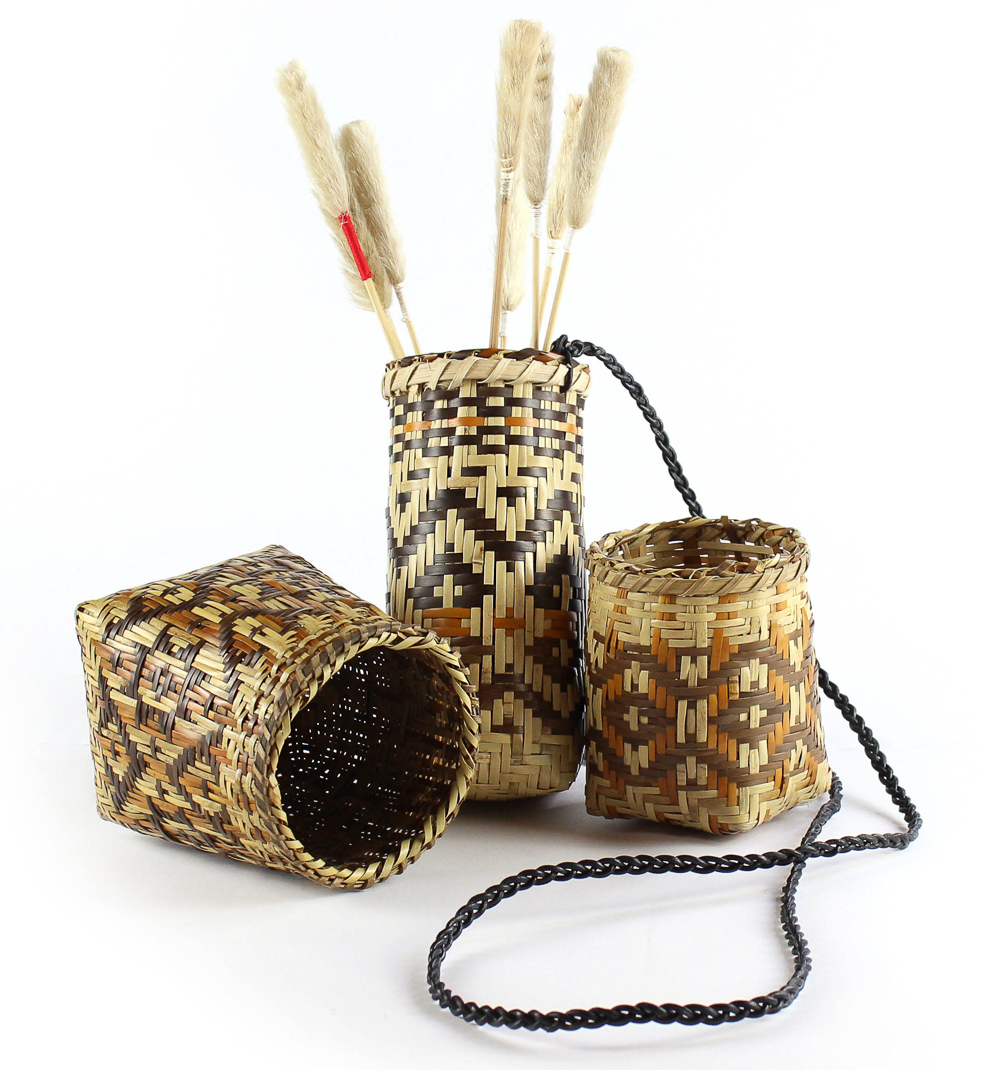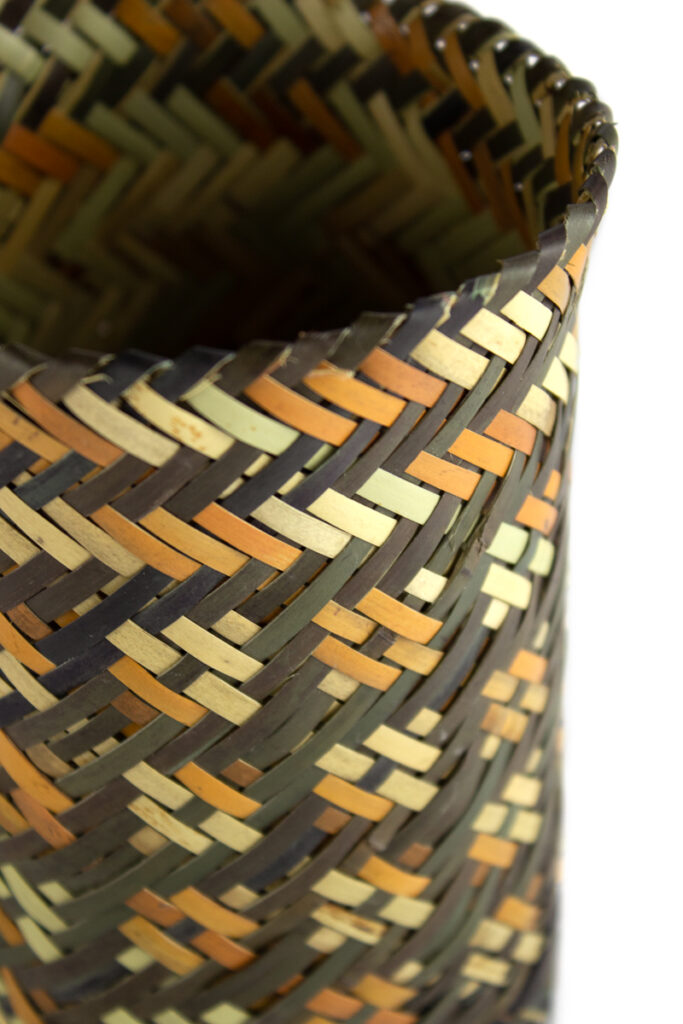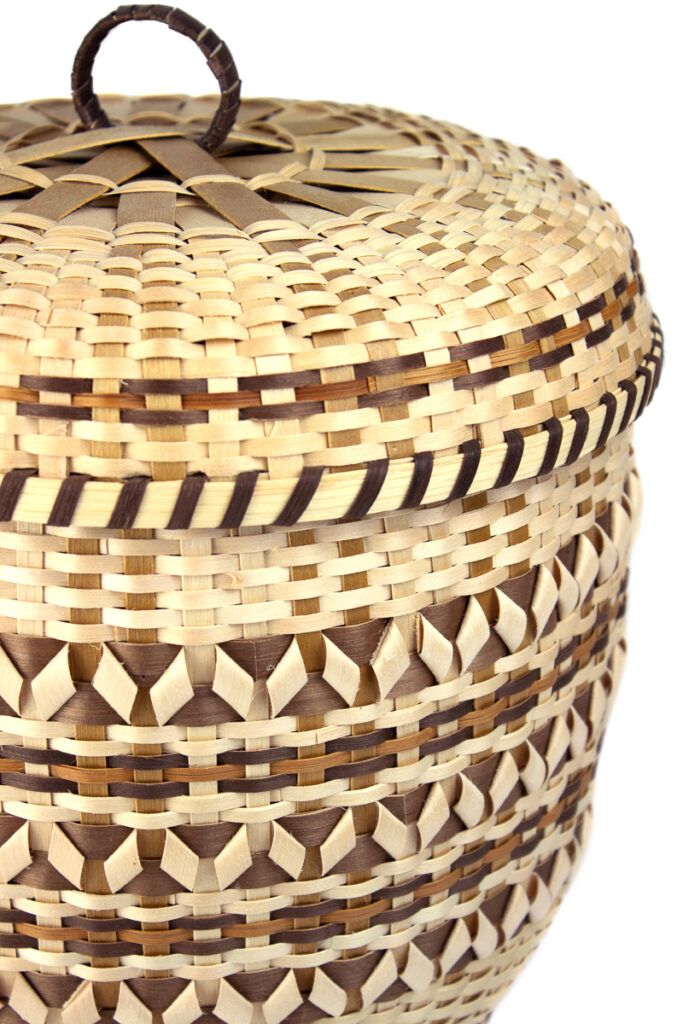
ᏗᎳᏂ Dylan Morgan, (left to right), Basket, 2019. Rivercane, walnut, butternut, bloodroot, hickory; Dart Quiver, 2021. Rivercane, walnut, butternut, bloodroot, hickory; Basket, 2020. Rivercane, bloodroot, walnut, white oak rim.
The ᎢᏛᏍᎦ ᏫᏥᏤᎢ ᎠᎵᏰᎵᏒ Weaving Across Time exhibition reflects the profound role of basket making in a custodianship of nature.
The Center for Craft’s exhibition ᎢᏛᏍᎦ ᏫᏥᏤᎢ ᎠᎵᏰᎵᏒ Weaving Across Time showcases the works of nine Eastern Band Cherokee basket makers. This exhibition is supported in part by the Cherokee Preservation Foundation, the National Endowment for the Arts, and AARP, Mountain Region North Carolina.
The artists work with two of the oldest materials in Cherokee basket-making tradition: mountain rivercane and white oak, both of which have been used for thousands of years by Southeastern tribes. The end results are both beautiful and functional—entries in an evolving craft tradition that began tens of thousands of years ago and is experiencing a resurgence. The labor-intensive process of basket making, which includes harvesting materials, gathering plants for dyes and deciding on intricate patterns, itself becomes a key component of the final object, which interweaves ecology, culture, land, and identity.
These plants, particularly rivercane, are at the heart of Cherokee tradition and culture. The subject of serious conservation efforts, rivercane is also a vital plant for water quality and erosion mitigation, as well as a habitat for riparian species. Despite its importance, the effects of climate change and continually encroaching development in rivercane habitats has contributed to its depletion, both as a material for artists and a plant essential for environmental health. Basketmakers harvesting rivercane for splints approach the plant with deep reverence and knowledge of its centrality to the ecosystem, sometimes traveling hundreds of miles to harvest it sustainably.
- ᏚᏍᏓᏯᎫᎾᏱ Gabriel Crow, Eye of the Sacred Bird, 2020.
- Lucille Lossiah. Rivercane double weave with lid. Natural, butternut, bloodroot.
- Ramona Lossie. Rivercane, butternut, bloodroot.
Other materials, selected with just as much care, reveal elements of process and the natural environment, including the plants available to harvest in particular seasons. White oak can be gathered year-round, but is easiest to process in spring and summer when the sap runs up the tree. Dyes used for the baskets, sourced from plants including bloodroot, butternut, and walnut, add rich color to final pieces while also revealing information about harvest time and supply. The laborious, intensive process links generations of basket makers across centuries.
As Cherokee lands have been stolen or transformed beyond recognition, materials are harder to come by, but the rewards are rich. As basket maker ᏚᏍᏓᏯᎫᎾᏱ Gabriel Crow, explains, “When you’re taking that extra step, going out and doing this completely by hand, you’re a basket maker, not just a weaver. My hands are rough and calloused over because I make the splints myself.” Crow makes an average of just 20 baskets a year and, like other basket makers, wastes no scraps, instead making mats, miniature pieces, or, as a last resort, using them for kindling.
The baskets in the exhibition, all of which were created in the last two decades, connect lineages across time and space in a vibrant, living tradition. Patterns based on rhythmic numerical sequences are passed down from teacher to student. Basket makers also borrow from contemporaries and innovate to create pieces in their own recognizable styles. Basket maker ᎺᎵ ᏔᎻᏏᏂ Mary W. Thompson, who is also the consulting artist for The Basket public art parklet, finds inspiration in designs she sees on her travels to visit other tribes in North and South America. For her, baskets are symbolic of Cherokee resilience. “The Cherokee have always been able to change and adapt with time,” she says, “so our artwork and art forms have changed and evolved along with us.”
ᎢᏛᏍᎦ ᏫᏥᏤᎢ ᎠᎵᏰᎵᏒ Weaving Across Time is at the Center for Craft, Ashville, North Carolina, USA 13 December 2021 – 22 April 2022.




